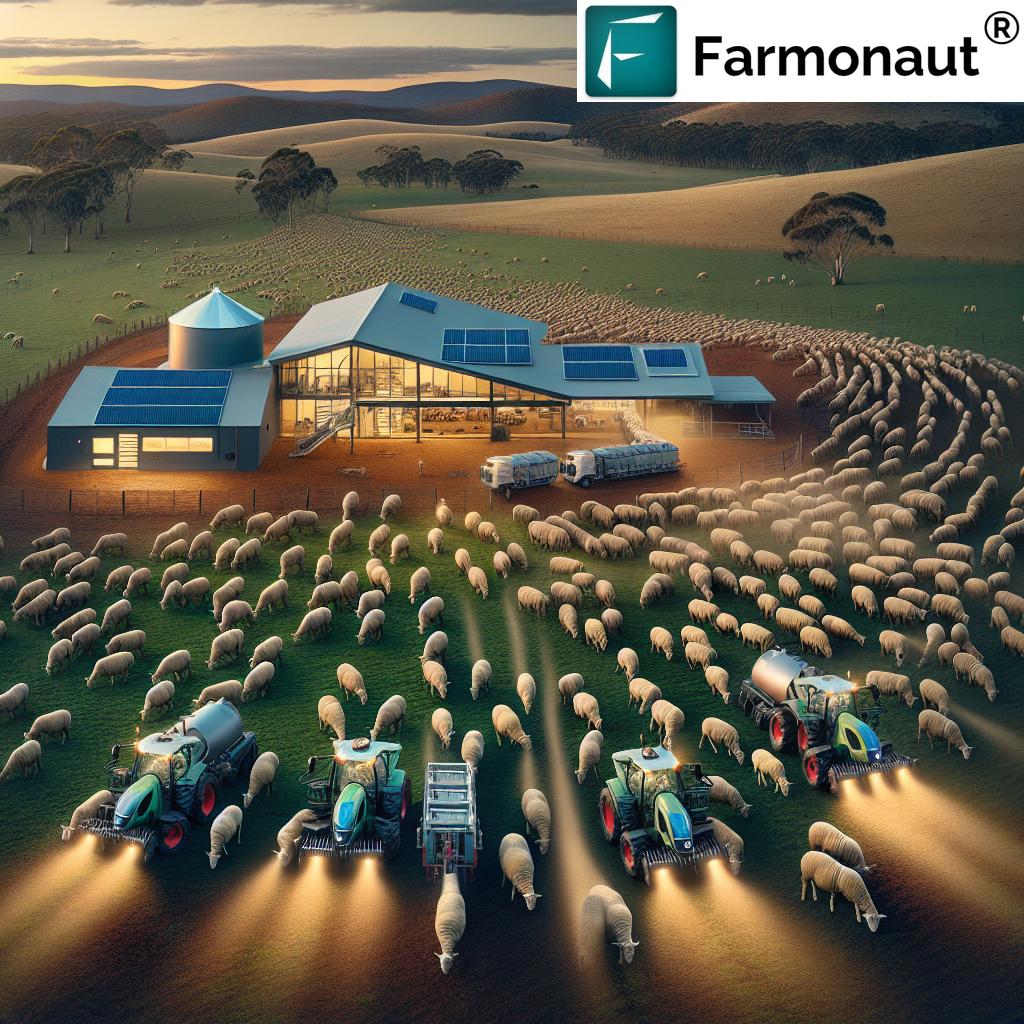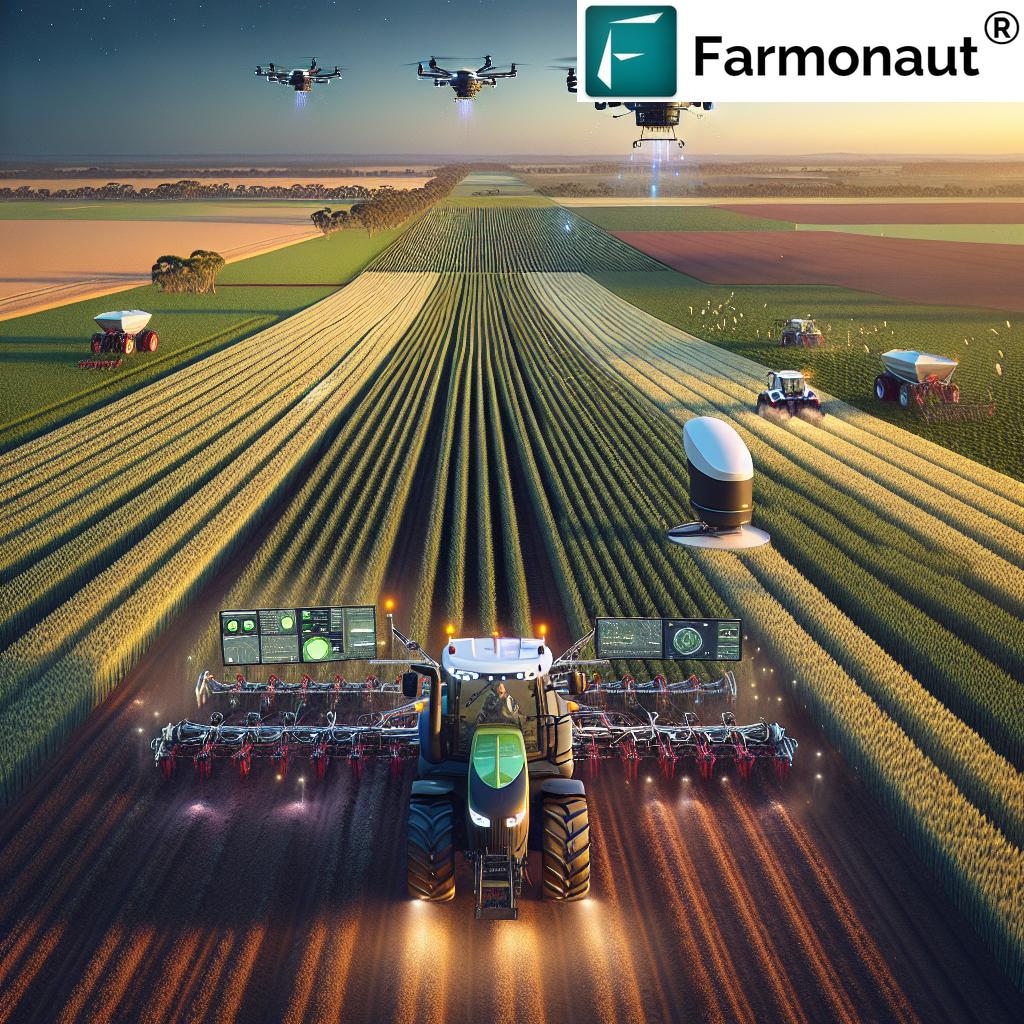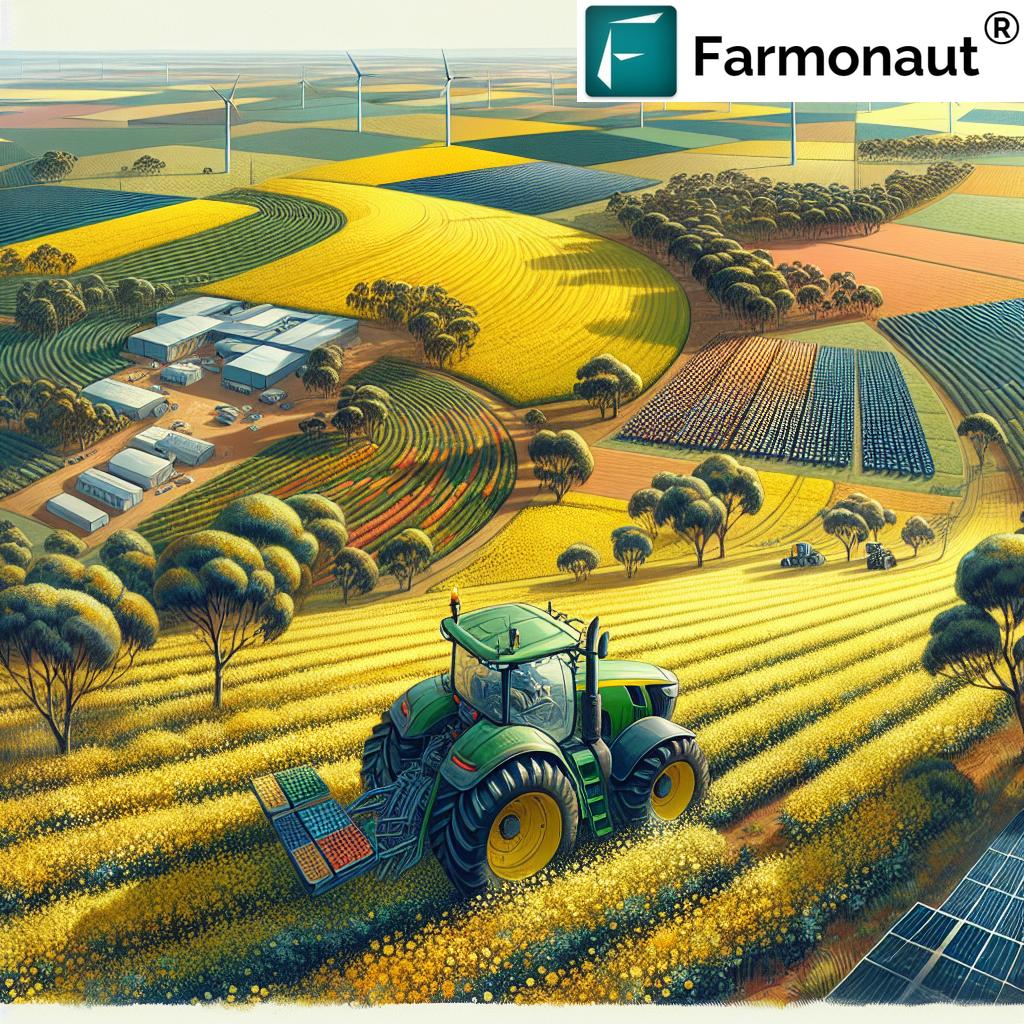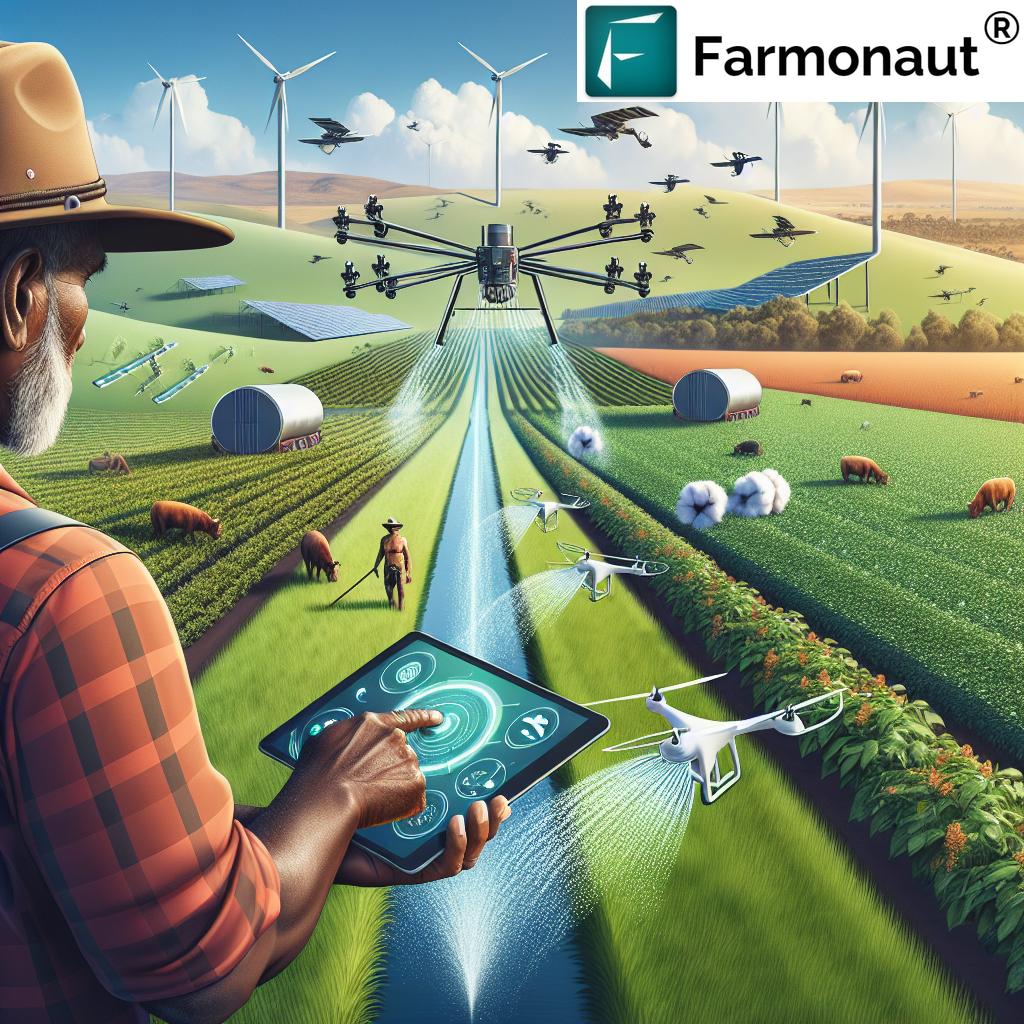Revolutionizing Australian Agribusiness: Digital Innovations for Sustainable Sheep Farming and Exports
“Australian sheep farmers adopting digital agriculture solutions have seen up to 15% increase in wool production efficiency.”
In the vast expanse of Australia’s agricultural landscape, a revolution is unfolding. The integration of digital innovations and sustainable agriculture practices is reshaping the face of agribusiness, particularly in the realm of sheep farming and wool production. As we delve into this transformative journey, we at Farmonaut are excited to explore how these advancements are not only boosting productivity but also ensuring the long-term sustainability of one of Australia’s most iconic industries.
The Digital Dawn in Australian Agriculture
The Australian agricultural sector has long been a cornerstone of the nation’s economy, with sheep farming playing a pivotal role. However, the challenges of climate change, resource scarcity, and global market demands have necessitated a shift towards more innovative and sustainable practices. This is where digital agriculture steps in, offering a suite of tools and technologies that are revolutionizing the way we approach farming.

At the forefront of this digital revolution are technologies such as:
- Precision farming technology: Utilizing GPS, sensors, and data analytics to optimize resource use
- Livestock management solutions: Advanced tracking and monitoring systems for animal health and welfare
- Smart farming techniques: IoT devices and AI-driven decision support systems
- Agricultural data analytics: Big data processing for informed decision-making
These innovations are not just improving efficiency; they’re paving the way for a more sustainable and resilient agricultural sector. Let’s explore how these technologies are specifically impacting the sheep farming industry in Australia.
Transforming Sheep Farming with Digital Solutions
The Australian wool industry, contributing approximately $3.6 billion annually to the country’s economy, is experiencing a significant boost from technological advancements. Here’s how digital innovations are reshaping various aspects of sheep farming:
Precision Livestock Management
One of the most significant advancements in sheep farming is the implementation of precision livestock management systems. These systems utilize a combination of GPS tracking, RFID tags, and sensors to monitor individual animals’ health, location, and behavior. This level of detailed monitoring allows farmers to:
- Detect health issues early, reducing mortality rates
- Optimize grazing patterns for better pasture management
- Improve breeding programs through data-driven selection
By leveraging these livestock management solutions, Australian sheep farmers are seeing remarkable improvements in productivity and animal welfare.
Pasture Management and Optimization
Effective pasture management is crucial for sustainable sheep farming. Digital technologies are revolutionizing this aspect through:
- Satellite imagery and drones for real-time pasture assessment
- AI-powered analytics for predicting optimal grazing times
- Soil sensors for monitoring moisture levels and nutrient content
These smart farming techniques enable farmers to make data-driven decisions about pasture rotation, irrigation, and fertilization, leading to more sustainable land use and improved feed quality for livestock.
Wool Quality Assessment and Traceability
The quality of wool is paramount in the global market. Digital innovations are enhancing both the assessment and traceability of wool:
- Advanced imaging technology for accurate fiber measurement
- Blockchain-based systems for end-to-end traceability
- IoT devices for monitoring storage conditions
These technologies not only ensure premium quality but also meet the growing consumer demand for transparency in the supply chain.
Sustainable Practices in Australian Sheep Farming
Sustainability is at the heart of the digital revolution in Australian agriculture. As we embrace these technological advancements, it’s crucial to understand how they contribute to more sustainable farming practices:
Resource Efficiency
Precision farming technology allows for more efficient use of resources such as water, feed, and fertilizers. By precisely monitoring and controlling inputs, farmers can:
- Reduce water usage through targeted irrigation
- Optimize feed allocation based on individual animal needs
- Minimize fertilizer use through precision application
This not only reduces costs but also minimizes the environmental impact of farming operations.
Soil Health Management
Maintaining soil health is crucial for sustainable agriculture. Digital tools are enabling farmers to:
- Monitor soil pH and nutrient levels in real-time
- Implement precision fertilization strategies
- Track carbon sequestration in pastures
By leveraging agricultural data analytics, farmers can make informed decisions about soil management, contributing to long-term land sustainability.

Biodiversity Conservation
Digital technologies are also playing a role in biodiversity conservation on sheep farms:
- Drones and satellite imaging for monitoring native vegetation
- AI-powered species identification for tracking wildlife populations
- Precision fencing to protect sensitive habitats while optimizing grazing areas
These efforts ensure that sheep farming can coexist with and even enhance local ecosystems.
The Role of Farmonaut in Australian Agribusiness
At Farmonaut, we’re proud to be at the forefront of this digital revolution in agriculture. Our satellite-based farm management solutions are designed to empower Australian farmers with the tools they need to embrace sustainable and efficient farming practices.
Explore our solutions:
Our platform offers:
- Real-time crop health monitoring using satellite imagery
- AI-powered advisory systems for optimized farm management
- Weather forecasting and analysis for informed decision-making
- Resource management tools for improved efficiency
For developers and businesses looking to integrate our technology into their systems, we offer robust API solutions:
The Future of Australian Sheep Farming and Exports
As we look to the future, the integration of digital technologies in Australian sheep farming is set to play an even more significant role. Here are some trends we anticipate:
Advanced Genomics and Breeding Programs
The use of genetic data and AI-driven analytics will enable more precise breeding programs, leading to:
- Improved wool quality and yield
- Enhanced disease resistance in sheep populations
- Better adaptation to changing climatic conditions
Automated Farm Operations
Increasing automation in farm operations will revolutionize day-to-day tasks:
- Robotic shearing systems for more efficient wool harvesting
- Autonomous vehicles for pasture management and livestock monitoring
- AI-driven decision support systems for farm management
Enhanced Export Capabilities
Digital innovations will also boost Australia’s sheep and wool export capabilities:
- Blockchain-based traceability systems for improved market access
- Real-time quality assurance technologies for meeting international standards
- Digital platforms for direct farmer-to-consumer connections in global markets
Challenges and Opportunities
While the future of digital agriculture in Australia is promising, it’s not without its challenges:
Digital Literacy and Adoption
One of the primary challenges is ensuring that farmers, especially those in remote areas, have the skills and resources to adopt new technologies. This presents an opportunity for:
- Educational programs focused on digital literacy for farmers
- Government initiatives to support technology adoption in rural areas
- Partnerships between tech companies and agricultural organizations for knowledge transfer
Data Privacy and Security
As farming becomes increasingly data-driven, addressing concerns about data privacy and security is crucial. This calls for:
- Robust data protection policies and frameworks
- Transparent data handling practices by agtech companies
- Farmer-centric approaches to data ownership and control
Infrastructure Development
The success of digital agriculture relies heavily on robust digital infrastructure. Opportunities in this area include:
- Expansion of high-speed internet coverage in rural areas
- Development of IoT networks specifically designed for agricultural applications
- Investment in cloud computing and data storage solutions for farm data
Comparative Analysis: Traditional vs. Digital Sheep Farming
To fully appreciate the impact of digital innovations on Australian sheep farming, let’s compare traditional methods with their digital counterparts:
| Farming Aspect | Traditional Method | Digital Innovation | Potential Impact |
|---|---|---|---|
| Livestock Monitoring | Manual counting and visual health checks | IoT sensors and AI-powered health monitoring systems | 20% reduction in mortality rates; 15% increase in early disease detection |
| Pasture Management | Visual assessment and experience-based decisions | Satellite imagery and AI-driven analytics for optimal grazing patterns | 30% improvement in pasture utilization; 25% reduction in overgrazing |
| Wool Quality Assessment | Manual grading and subjective evaluation | Advanced imaging technology and blockchain-based traceability | 40% increase in premium wool classification; 50% improvement in supply chain transparency |
| Export Compliance | Paper-based documentation and manual inspections | Digital certification systems and real-time quality monitoring | 60% reduction in export documentation processing time; 35% decrease in compliance-related delays |
This comparison clearly illustrates the transformative potential of digital technologies in enhancing efficiency, quality, and sustainability across various aspects of sheep farming.
The Role of Policy and Regulation
As the Australian agribusiness sector embraces digital innovations, the role of policy and regulation becomes increasingly important. Key areas of focus include:
Incentivizing Technology Adoption
Government policies play a crucial role in encouraging farmers to adopt new technologies:
- Tax incentives for investment in digital farming equipment
- Grants and subsidies for small and medium-sized farms to access digital tools
- Research and development funding for agtech innovations
Data Governance Frameworks
As farming becomes more data-intensive, establishing clear guidelines for data management is essential:
- Development of national data standards for agricultural data
- Regulations ensuring farmer ownership and control of farm data
- Guidelines for ethical use of AI and machine learning in agriculture
Export Regulations and Standards
Digital innovations are also impacting export regulations and standards:
- Integration of blockchain technology for verifiable export certifications
- Development of digital traceability standards for international markets
- Harmonization of data exchange protocols with major trading partners
Environmental Impact and Sustainability
The adoption of digital technologies in sheep farming is not just about improving productivity; it’s also about enhancing environmental sustainability. Here’s how these innovations are contributing to a more eco-friendly agricultural sector:
Reduced Carbon Footprint
Digital farming practices are helping to reduce the carbon footprint of sheep farming:
- Precision feed management reducing methane emissions from livestock
- Optimized transportation routes lowering fuel consumption
- Smart energy management systems on farms
Water Conservation
In a country often affected by drought, water conservation is crucial:
- Precision irrigation systems reducing water waste
- AI-powered weather forecasting for better water management
- Soil moisture sensors optimizing water usage in pastures
Biodiversity Preservation
Digital tools are also aiding in preserving biodiversity on sheep farms:
- Satellite monitoring of native vegetation and wildlife habitats
- Precision application of pesticides reducing impact on non-target species
- Data-driven land use planning for balancing production and conservation
The Economic Impact of Digital Innovations in Sheep Farming
The adoption of digital technologies in Australian sheep farming is having a significant economic impact:
Increased Productivity
Digital innovations are driving substantial productivity gains:
- 15-20% increase in wool yield per sheep
- 25-30% reduction in labor costs through automation
- 10-15% improvement in overall farm efficiency
Market Access and Premium Pricing
Digital traceability and quality assurance are opening new market opportunities:
- Access to premium markets demanding verified sustainable practices
- 5-10% price premium for digitally traceable wool products
- Expanded export opportunities through improved compliance capabilities
Cost Savings
Precision farming techniques are leading to significant cost reductions:
- 20-25% reduction in feed costs through optimized nutrition management
- 15-20% savings on veterinary expenses due to better health monitoring
- 10-15% decrease in overall operational costs
“The Australian wool industry contributes approximately $3.6 billion annually to the country’s economy, with technology driving growth.”
Future Trends and Innovations
Looking ahead, several emerging trends and innovations are set to further transform Australian sheep farming:
Artificial Intelligence and Machine Learning
AI and ML will play an increasingly important role:
- Predictive analytics for disease outbreaks and market trends
- Automated decision-making systems for day-to-day farm management
- Advanced image recognition for individual sheep identification and health monitoring
5G and Internet of Things (IoT)
The rollout of 5G networks will revolutionize farm connectivity:
- Real-time data transmission from thousands of farm sensors
- Enhanced remote monitoring and control of farm equipment
- Improved capabilities for precision livestock management
Vertical Integration and Direct-to-Consumer Models
Digital platforms are enabling new business models:
- Blockchain-powered direct selling of wool products to consumers
- Virtual marketplaces connecting farmers directly with global buyers
- Customized wool products based on consumer preferences and traceability data
Conclusion: A Digital Future for Australian Sheep Farming
As we’ve explored throughout this blog, the integration of digital innovations in Australian sheep farming is not just a trend; it’s a fundamental shift in how we approach agriculture. From precision livestock management to sustainable farming practices, these technologies are reshaping the industry, making it more efficient, sustainable, and competitive on the global stage.
At Farmonaut, we’re committed to being a part of this digital revolution, providing farmers with the tools and insights they need to thrive in this new era of agriculture. As we look to the future, we see endless possibilities for innovation and growth in the Australian sheep farming sector.
The journey towards a fully digitalized agricultural sector is ongoing, and it will require continued collaboration between farmers, technology providers, researchers, and policymakers. However, the potential rewards – in terms of productivity, sustainability, and economic growth – make this a journey well worth undertaking.
As we conclude, we invite you to explore how Farmonaut can support your farming operations in this digital age. Whether you’re looking to optimize your pasture management, improve your livestock monitoring, or enhance your export capabilities, our solutions are designed to meet the unique needs of Australian sheep farmers.
FAQs
- How can digital technologies improve wool quality in sheep farming?
Digital technologies can improve wool quality through precision nutrition management, stress monitoring, and optimal shearing timing based on data analytics. - What are the main challenges in adopting digital farming practices for small-scale sheep farmers?
The main challenges include initial investment costs, digital literacy, and access to reliable internet connectivity in remote areas. - How does satellite imagery help in pasture management for sheep farming?
Satellite imagery provides real-time data on pasture health, growth rates, and carrying capacity, enabling more efficient grazing management and rotation planning. - Can digital technologies help in reducing the environmental impact of sheep farming?
Yes, through precision resource management, reduced chemical use, and improved carbon sequestration in pastures, digital technologies can significantly reduce the environmental footprint of sheep farming. - How are blockchain technologies being used in the Australian wool industry?
Blockchain is being used for end-to-end traceability of wool products, ensuring authenticity, improving supply chain transparency, and meeting consumer demands for ethical sourcing.
















